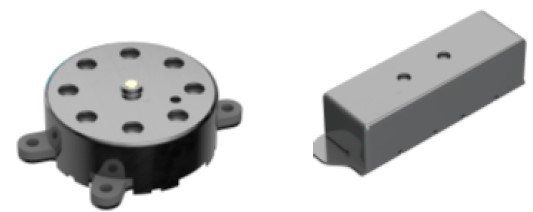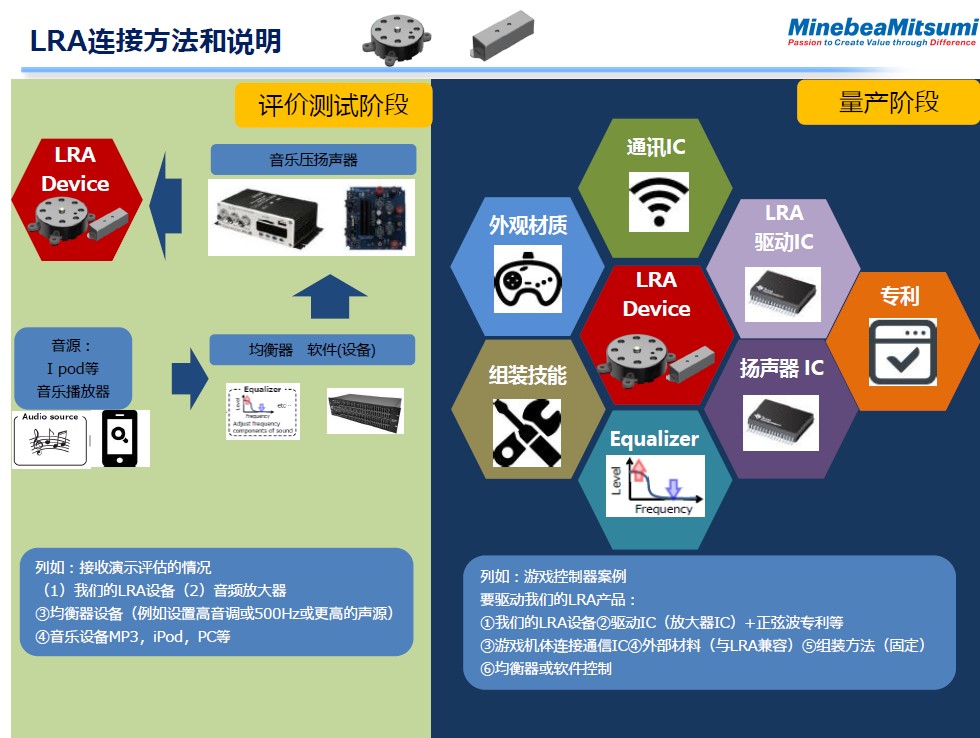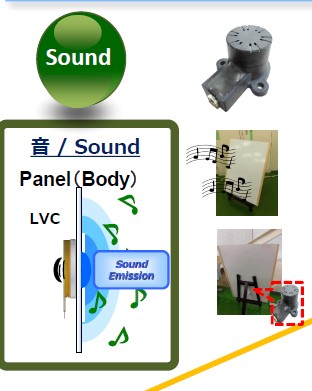Introduction of MinebeaMitsumi LRA - Linear Resonant Actuator


This technical article introduces the operating principles, advantages, and features of the MinebeaMitsumi Linear Resonant Actuator (LRA).
▼What is a Linear Resonant Actuator:
Unlike traditional vibration motors, which operate by spinning an off-balance mass, LRAs use a magnetic mass that moves back and forth in a linear motion within the bounds of its casing.
• Market Applications:
Used in smartphones, wearable electronic devices, game controllers, and other terminal devices as a small electronic component that simulates "vibration touch", "operational feel", and "sound" effects.
• Tactile Sensation:
Simulates subtle "vibrations" to create a "tactile" sensation, offering realism and immersive gaming experiences. The rich expressiveness in synchronization with audio can simulate "roughness", "heaviness", "smoothness", and "tugging" sensations.
• Auditory Sensation:
Can be utilized as a speaker, its vibrational principle is akin to acoustics, also capable of creating surround sound effects, offering three-dimensional sound for flat environments.
Using MinebeaMitsumi's proprietary patented technology, it eliminates excessive resonance and simulates more precise, delicate tactile responses.
▼Differences between general vibration motors and linear motors:
| Vibration Motor (ERM) | Linear Motor (LRA) | |
| Principle |
Using the principle of electromagnetic induction, electromagnetic force drives the rotation of the motor's axis. This, in turn, drives the rotation of an eccentric iron or hammer. The centrifugal force generated allows the motor to rotate and vibrate rapidly. |
A spring mass block moving in a linear fashion, directly converting electrical energy into linear mechanical motion. |
| Advantages |
|
|
| Disadvantages | Start and stop times are slower, and the vibrational feedback is more monotonous. If a brushed motor is used, it consumes more power. | Cost is relatively higher compared to ERM. The vibrating mass inside the LRA is made of rare-earth elements, allowing for a uniform vibration waveform. |
▼MinebeaMitsumi Linear Motor (LRA) connection methods and explanations:

▼MinebeaMitsumi Linear Motor (LRA) sound production method:
LRA uses the frequency of vibration through a medium as its sound-emitting medium, as illustrated below. Advantages of sound emission through this medium include:
Advantages of sound emission through this medium include:
- Innovative design.
- Lightweight.
- Energy-saving.
▼Introduction to Linear Motor (LRA) video (Horustech Official VTuber Channel):
▼Learn more about LRA (Japanese):
https://www.eminebea.com/jp/product/electronic/resonant/lra/
https://www.minebeamitsumi.com/product/electronic/1196973_6184.html
https://www.eminebea.com/jp/news/2019/resonant.shtml
https://www.eminebea.com/jp/product/electronic/resonant/
▼Japanese program introducing MinebeaMitsumi LRA:
https://www.youtube.com/watch?v=xEPlMLZGQ0c
Horustech Electronics is an authorized distributor for Japan's MinebeaMitsumi LRA Linear Motor products. If interested, please contact us.
Our Official Accounts:YouTube | Facebook | Twitter
